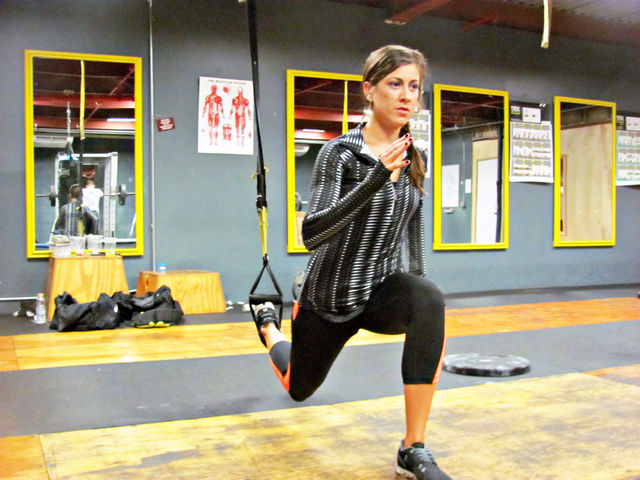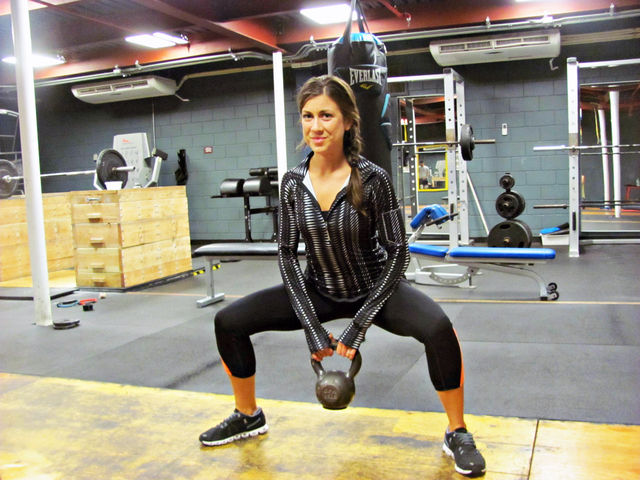Talk Story: Cynthia Fowler
From teaching seniors aqua aerobics to working as a personal trainer at the Kauai Athletic Club, Cynthia Fowler has a passion for helping people live a healthier lifestyle.
“I like seeing a client master something they had to work for. And that could mean anything — they lost the weight they wanted to lose, or there’s an exercise they couldn’t do in the beginning, and I said, ‘well, that’s your goal, we’ll get there’ and the day comes that they can do it,” she said. “That’s tops to me — seeing progress, and them seeing progress.”
Born and raised in Tampa, Florida, Fowler, 26, moved to Kauai about three years ago, when her husband wanted to return to his native Kauai.
A few months later, she got a job at KAC teaching group fitness classes and working as a personal trainer.
“KAC was the the first place on Kauai to give me a chance to spread my wings as a personal trainer,” she said.
In addition to working at KAC, Fowler is an instructor and trainer at the Club at Kukuiula and Ho’ola Lahui Hawaii.
Between the three places, she teaches cycling, Pi Yo, circuit training, boot camp, corrective exercise and aqua aerobics.
But her heart is in personal training.
“I don’t mind teaching format classes, but I love it when I get to design classes myself,” she said.
How long have you been a trainer?
About five years. I started when I was 21, that’s when I got certified.
I was certified first as a personal trainer, then I decided to go ahead and go for the bachelor’s degree in exercise science. The online program is through California University of Pennsylvania. They’re partnered with NASM, the company I got my personal trainer certification through.
How long does it take to get a certification?
Just to be certified as a personal trainer, you can get that done in six months if you wanted. But it depends on whether you take the shortcuts or study everything and take your time.
I actually got certified before I started the school, but I wanted to take my time. But it’s good for someone who’s going to be a personal trainer, even if they’re not going to go for their full bachelor’s degree, to take some college classes in anatomy, physiology and biomechanics. They really don’t give you enough in a personal training certification to be really successful, so you have to go beyond that.
The personal trainer certification is very general and very basic —how can you help people feel better and get fit without hurting them. But when you go beyond that and start learning the anatomy, physiology and kinesiology, then you get to focus more on performance.
Originally, I wanted to work with triathletes and help them train for the Ironman. But since I haven’t done one yet, I thought that’d be kind of weird.
That’s my goal, though.
So is that a goal, the Ironman?
Yes. First, it’s a Spartan in August on Oahu.
Then it’s Ironman in Kona. But you have to do a qualifier first. You have to do a half Ironman before you can do a full one. You have to get a decent time in the half to qualify to do the full one.
How long has that been a goal?
Since before I was a personal trainer.
The goal for Spartan happened this year. But I like to attack: for the Spartan, there’s different level races, and there’s something called the Trifecta. That’s the award you get for running all the races. You can come back each year until you get the Trifecta medal. Or you can do what’s called the Trifecta Weekend, which is when you do all the races in one weekend. And that’s what I’m doing in August.
Why did you want to take that extra step to go to school?
In Tampa, personal training is really competitive, and there are so many cookie cutter trainers.
A lot of people who are competing for the positions are just getting a quick certification. I remember when I was teaching spin classes, I would watch the trainers walk around. They were taking people from machine to machine, barely paying attention to their clients, and I was disgusted. I didn’t want to be that kind of trainer. Machines can be useful, but I would much rather someone use their own balance and rely on their own senses. The machines don’t get them doing that.
That’s when I realized I want to go to school. Because, if someone tells me they have a pain, I’ll know how to help them instead of just giving them this one size fits all program. Every individual body is different, so no workout should be identical to another person’s.
How did you get your start as a trainer?
The gym was my outlet when I was younger.
When I was 16, my parents were having problems. So I would sneak out at night to walk a few miles to the gym and work at 1 a.m. or 2. Nobody knew I was gone.
I didn’t know what I was doing at first, I was just watching other people. From there, I wound up working at the front desk, and the more I worked there, and saw people working out there, I just realized: ‘Man, I love this. I should go into that field and be a trainer.’
Why did you choose that path?
I just loved watching the other trainers at my gym see those results and the way that people changed with their regular training. I wanted to do that same thing for people.
Are there any nuances to being a personal trainer people usually don’t think about?
It’s hard when you have to deal with things in your personal life. There are days where you have to suck it up, and there are times you have to reschedule. But clients depend on you, and even if it’s a good reason, you just have to suck it up sometimes.
I think that sometimes you definitely have to put the enthusiasm there, even if you don’t technically feel enthusiastic because your client isn’t going to feel motivated in their workout if you’re feeling lethargic.
A personal trainer should also practice what they preach. So a lot of it is spending the time to back up what you’re telling your clients and doing it yourself. If I tell my clients they need to spend the extra time to foam roll and stretch, I got to do it too. If I tell my clients the need to be in the gym 4 to 5 times a day to see the results they want, I’ve got to be in the gym 4 to 5 times a week myself.
How often do you go to the gym on your own?
On average, I probably work out too much.
I’m usually working out, between my workout, and a class I’m teaching, twice a day. I’ll do my gym workout, but then I’ll maybe have to teach Pi Yo or cycling.
I also try to swim. I tell myself that even if I don’t have my Ironman planned yet, I should probably maintain a level of swim ability.
What’s it like trying to balance different clients?
I just have built up a client base in the last few months. Before my focus was on teaching. Now my focus is on personal training. And I train clients at different places too, like the beach. I see between six and eight clients a week.
What’s the difference between training and teaching?
Group fitness is always going to be different because I don’t get to satisfy desire as a personal trainer when I’m group training.
I have to shut up a little bit more and sometimes let people do things incorrectly in a group that I would address if I was working with them one-on-one. Group exercise is timed or choreographed, so I can’t just stop and address one person. Classes are fun and are great way to get in better shape, but it’s not going to be a menu of exercises designed specifically for you; it’s more like an all you-can-eat buffet.
Do most people start young, or are you kind of an anomaly?
I’m kind of young for it. A lot of people I’ve known who are all trainers and have gone through the process with have all been older than me.
Do you have any advice for other young people who want to be a personal trainer?
It takes time to get experience. So I would say to go through the bachelor’s program, or do something that will give you more, so you’re not just a young pup.



